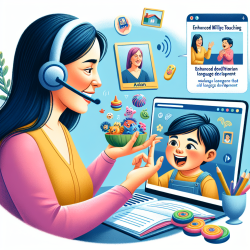As a speech-language pathologist, the quest for innovative and effective interventions is paramount, especially when working with children. The study titled "The Effects of Virtual Caregiver Coaching in Antigua & Barbuda on the Implementation of EMT Language Support Strategies in Naturalistic Environments" offers compelling evidence on the power of telepractice in enhancing caregiver-implemented interventions. Here’s how you can leverage the findings from this research to improve your practice and outcomes for children.
The Power of Caregiver Coaching
The research underscores the significance of coaching caregivers in using Enhanced Milieu Teaching (EMT) strategies. EMT is a naturalistic intervention that integrates social and behavioral approaches to language development. It involves four key strategies:
- Matched Turns: Responding to the child's communication attempts by matching their actions or words.
- Expansions: Adding words to the child's utterances to model more complex language.
- Time Delays: Pausing to give the child an opportunity to initiate communication.
- Prompting: Using cues to encourage the child to communicate.
Implementing the TMCR Method
The study utilized a slightly modified version of the Teach-Model-Coach-Review (TMCR) method. This approach can be integrated into your practice through telepractice, allowing you to reach families in underserved areas. Here’s a brief outline of the TMCR method:
- Teach: Introduce the language strategies to the caregiver using educational materials and examples.
- Model: Demonstrate the strategies through videos or live interactions.
- Coach: Provide real-time feedback as the caregiver practices the strategies with their child.
- Review: Reflect on the caregiver’s implementation and discuss improvements.
Positive Outcomes
The study reported significant improvements in caregiver responsiveness and the use of language support strategies. Caregivers demonstrated increased use of matched turns, expansions, and environmental arrangements. This resulted in better communication opportunities for the children, enhancing their language development.
Why Telepractice?
Telepractice offers several advantages:
- Accessibility: Reaches families in remote or underserved areas.
- Flexibility: Provides scheduling convenience for both practitioners and families.
- Cost-Effectiveness: Reduces travel and associated costs.
Encouraging Further Research
While the study’s findings are promising, continued research is essential. Practitioners are encouraged to explore the following areas:
- Long-term effects of caregiver coaching on child language outcomes.
- Adaptations of EMT strategies for diverse cultural contexts.
- Comparative studies between telepractice and in-person interventions.
To read the original research paper, please follow this link: The Effects of Virtual Caregiver Coaching in Antigua & Barbuda on the Implementation of EMT Language Support Strategies in Naturalistic Environments.










